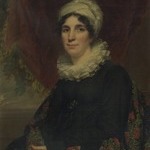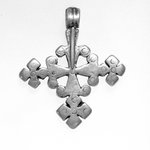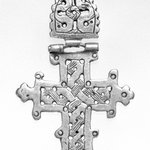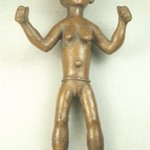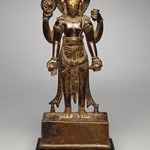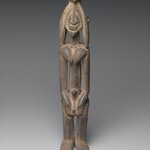

Amhara artist. Processional Cross (qäqwami mäsqäl), 13th or 14th century. Copper alloy, 10 × 4 3/4 × 1 in. (25.4 × 12.1 × 2.5 cm). Brooklyn Museum, Gift of Eric Goode, 2000.95.1. Creative Commons-BY (Photo: , 2000.95.1_front_PS9.jpg)
Processional Cross (qäqwami mäsqäl)
Arts of Africa
The African Kingdom of Aksum (present-day Ethiopia) adopted Christianity around 330 C.E., not long after the religion was first legalized in the Roman empire. Its artists have demonstrated extraordinary creativity in making crosses, which the Ethiopian Orthodox Church links both to Jesus’s Crucifixion and to the Tree of Life mentioned in the Book of Genesis. This interpretation is reflected in the foliate and natural forms present in this group of processional crosses. The elaborate interlaced motifs here first emerged during the medieval era. The cross on the right features incised images of archangels, saints, and the Virgin Mary holding the Christ Child.
The symbol of the cross unites Christian communities worldwide and, like their Italian Catholic counterparts, Ethiopian Orthodox priests would have originally carried these crosses atop staffs for use during the liturgy and processions.
The symbol of the cross unites Christian communities worldwide and, like their Italian Catholic counterparts, Ethiopian Orthodox priests would have originally carried these crosses atop staffs for use during the liturgy and processions.
CULTURE
Amhara artist
MEDIUM
Copper alloy
DATES
13th or 14th century
DIMENSIONS
10 × 4 3/4 × 1 in. (25.4 × 12.1 × 2.5 cm)
mount (wall mount - m2): 10 × 4 3/4 × 7 in. (25.4 × 12.1 × 17.8 cm) (show scale)



COLLECTIONS
Arts of Africa
ACCESSION NUMBER
2000.95.1
CREDIT LINE
Gift of Eric Goode
CATALOGUE DESCRIPTION
Cast bronze processional cross with rectangular openwork superstructure and socket with decagonal cross section. The superstructure has a central motif of five small cutout Greek crosses arranged in a larger Greek cross design. Two sets of three crosses form the vertical edges of the composition; three upper crosses appear to have broken off and been roughly sanded.
Condition: Good overall
MUSEUM LOCATION
This item is not on view
CAPTION
Amhara artist. Processional Cross (qäqwami mäsqäl), 13th or 14th century. Copper alloy, 10 × 4 3/4 × 1 in. (25.4 × 12.1 × 2.5 cm). Brooklyn Museum, Gift of Eric Goode, 2000.95.1. Creative Commons-BY (Photo: , 2000.95.1_front_PS9.jpg)
IMAGE
front, 2000.95.1_front_PS9.jpg., 2019
"CUR" at the beginning of an image file name means that the image was created by a curatorial staff member. These study images may be digital point-and-shoot photographs, when we don\'t yet have high-quality studio photography, or they may be scans of older negatives, slides, or photographic prints, providing historical documentation of the object.
RIGHTS STATEMENT
Creative Commons-BY
You may download and use Brooklyn Museum images of this three-dimensional work in accordance with a Creative Commons license. Fair use, as understood under the United States Copyright Act, may also apply.
Please include caption information from this page and credit the Brooklyn Museum. If you need a high resolution file, please fill out our online application form (charges apply).
For further information about copyright, we recommend resources at the United States Library of Congress, Cornell University, Copyright and Cultural Institutions: Guidelines for U.S. Libraries, Archives, and Museums, and Copyright Watch.
For more information about the Museum's rights project, including how rights types are assigned, please see our blog posts on copyright.
If you have any information regarding this work and rights to it, please contact copyright@brooklynmuseum.org.
RECORD COMPLETENESS
Not every record you will find here is complete. More information is available for some works than for others, and some entries have been updated more recently. Records are frequently reviewed and revised, and we welcome any additional information you might have.




